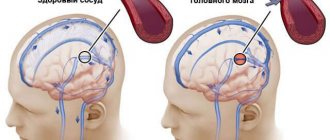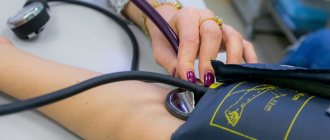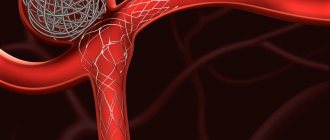Vascular crisis is a pathological condition that is characterized by a sharp change in the blood supply of blood vessels along with disruption of peripheral and central circulation. “Crisis” itself means a sudden manifestation of pathology, therefore it always develops acutely, in the form of some kind of attack or attack. In most cases, this condition requires emergency medical care for the patient. In accordance with the focus of the lesion, temporal, brainstem and hypothalamic crises are distinguished.
Also, there are two main groups of vascular crises - systemic and regional. Systemic crises are divided into hypertensive, hypotonic and vegetative-vascular. This category is distinguished by its clinical manifestation: they are characterized by changes in the total capacity of the peripheral veins or the total peripheral resistance to blood flow. Such crises are accompanied by a deviation from normal blood pressure values (increase or decrease). Patients often experience symptoms of secondary cardiac failure. Let's take a closer look at each type of systemic vascular crisis separately:
- hypertensive. It is characterized by an increase in both systolic and diastolic blood pressure. In this case, the patient develops a headache (usually of a pulsating nature), noise in the ears, and “spots” before the eyes. The skin of the neck and especially the face becomes hyperemic and reddened with injected sclera. Hemorrhages in the sclera of one eye are possible. During movements, these symptoms increase even more. With emotional stress, a feeling of nausea and vomiting, rapid heartbeat, a feeling of lack of air, and pronounced pain in the heart area may appear;
- hypotonic. This pathology is characterized by a sharp drop in both systolic and diastolic blood pressure. In this case, the patient experiences dizziness, a feeling of nausea, trembling in the upper extremities, increased sweating and general weakness of the body. Often people are tormented by constant noise and ringing in the ears, the skin becomes paler;
- vegetative-vascular. This is a large category, divided into four types. The sympathetic-adrenal type appears against the background of a sharp increase in adrenaline and activity of the sympathetic department of the central nervous system. This type is characterized by pronounced symptoms: headaches and anxiety appear, heartbeat and pulse increase. The upper and lower extremities become cold. The vegetative-vestibular type occurs in the following diseases of the central nervous system - acute cerebrovascular accident and encephalopathy. Patients experience a feeling of nausea and dizziness, loss of space. The vago-insular type is directly related to the influence of the parasympathetic part of the central nervous system. Patients experience tinnitus, vomiting, increased sweating and general weakness of the body. The hyperventilation type is characterized by a lack of air, which is accompanied by severe shortness of breath. In this case, the patient experiences tachycardia and increased sweating.
Regional crises are divided into cerebral crisis, angioedema, angiotrophoneurosis and migraine. All of them correspond to localized disturbances in the blood supply to a tissue or organ. With high systolic or diastolic pressure, there is a significant decrease in blood flow to the organ or a complete cessation. In the case of arterial hypotension, the blood flow to the organ is exceeded. Patients are diagnosed with stagnation of blood in the veins. Let's take a closer look at each type of regional vascular crisis separately:
- cerebral crisis. This pathology is preceded by atherosclerotic changes in the blood vessels of the brain. Cerebral crisis manifests itself in the form of headache, vestibular disorders (dizziness, nausea), and impaired fine motor skills. Some patients experience memory disorders, loss of space, the appearance of “floaters” before the eyes, and increased agitation. This may increase sensitivity to bright lights and loud sounds. In especially advanced clinical cases, patients begin to experience deviations from the mental system; they try to be in complete solitude and silence, since any sounds provoke a headache. Cerebral crisis can be primary or secondary. Primary pathologies arise against the background of organic brain damage due to a disorder of the regulatory centers of the functional systems of the body. Secondary pathology occurs as a result of disturbances in the functioning of the nervous system;
- angioedema. This type of regional vascular crisis, as a rule, appears under conditions of increased release of a large number of neurotransmitters (in particular, serotonin). In such a clinical situation, slight edema (swelling) appears in specific areas of the skin and mucous membranes, and part of the organ may be slightly increased in size. With angioedema there is no itching and discoloration of the skin, which makes it possible to differentiate it from a local vascular crisis;
- angiotrophoneurosis (Raynaud's disease). This type of vascular crisis is the most rare. Based on statistics, women are 4 times more susceptible to the disease than men. Patients experience a rapid change in spasm in a specific area of the body (usually the upper extremities). The appearance of angiotrophoneurosis is associated with a violation of innervation. As the pathology progresses, dystrophic changes appear in the tissues, cyanosis and swelling of the extremities are noted, and trophic ulcers may develop;
- migraine. It is one of the most popular variants of regional vascular crisis (30% of all cases). As a rule, the disease begins at a young age – 20-25 years. In this case, pronounced perivascular edema of the brain tissue is noted. The headache is sharp and dull, and may be accompanied by a feeling of nausea and general weakness of the body. Some patients experience pulsating pain in one half of the head. The disease is accompanied by increased irritability. There are three phases of migraine. The duration of the first is about 20-30 minutes, characterized by the absence of severe painful sensations. In the second phase, a throbbing headache appears. The final (third) phase is characterized by the appearance of perivascular edema and dull pain.
General information about hypertensive crisis
A sudden increase in blood pressure above generally accepted values in a short period of time should alert you.
This condition can develop in any person exposed to overexertion, emotional shock, and even as a consequence of an acute infectious disease.
Mechanism of development and causes of hypertensive crisis
It may appear as follows:
- Short-term and unexpected manifestation of the following symptoms: pain in the temporal and other areas of the head, difficulty breathing, high blood pressure.
- Increased pressure, discomfort or pain in the heart and occipital area, extraneous noise in the ears.
The causes of hypertensive crisis are divided into two groups. In the first:
- diseases of the brain and cervical spine of any origin;
- pathologies of the cardiovascular system: coronary disease, atherosclerosis, arterial hypertension, heart failure;
- diseases of the endocrine system (hyperthyroidism, diabetes, etc.);
- respiratory tract diseases (bronchial asthma);
- pathologies of the kidneys and urinary system (pyelonephritis, glomerulonephritis, etc.).
The second group (trigger) risk factors include:
- stress;
- physical fatigue;
- taking tonic medications;
- smoking;
- alcohol consumption;
- acute attack of angina.
Men are more predisposed to hypertensive crisis than women, especially over the age of 50-55 years.
main sources
With stable functioning, the system that controls the regulation of blood circulation in the brain works so that when blood pressure jumps, the tone of the cerebral arteries begins to increase, which makes it possible to prevent large amounts of blood from entering the vessels. If the activity of this mechanism is disrupted, a lack or excess of tonic influence occurs. If a patient’s blood pressure increases, then the reaction of the cerebral part of a tonic nature is small, so a large number of blood cells enter the vessels. Also, in this situation, a second compensatory device must work, the principle of which is to increase the tone of the venous area. Thanks to it, the accumulation of blood in the skull is reduced. If there is not a sufficient increase in tone, the patient begins to develop the described disease.
The main component of a hypertensive cerebral crisis is stagnant accumulations in the venous region of the brain, causing an accumulation of excess fluid in the closed cavity of the skull, which provokes a jump in blood pressure. Further, a large increase in arterial tone gives a signal in response to an increase in pressure, as a result of which disruptions in the blood supply to brain tissue occur with the subsequent spread of hypoxia and manifestations of an ischemic type of disease. First of all, the pathological process affects the parts that are most sensitive to the lack of oxygen, such as the cortex. Insufficient uniformity of the cerebral vascular cavity and the possible addition of vasospasm of local origin can cause the occurrence of abnormal places with the most severe attacks of ischemia, which are associated with diagnosed clinical symptoms.
A set of sequential phenomena that determine the mechanisms of formation and course of the disease of complex hypertensive cerebral crisis is considered to be the manifestation of hypotension with the deposition of blood cells in the venous region and ischemia of certain areas of the brain due to problems that have arisen in the capillary blood flow due to shunting of blood into the veins, avoiding the capillary section .
Classification of hypertensive crisis
Depending on the speed of development of the attack, there are:
- Type 1 crisis
- a sharp rise in systolic pressure and a decrease in the indicator with medical help (rapid course), throbbing headache, agitation, irritability, fever, sweating, tachycardia. - Type 2 attack
- a simultaneous increase in upper and lower blood pressure, slow development (from two days or more), decreased vision, hearing, drowsiness, lethargy, symptoms are difficult to eliminate even in a hospital setting. One of the causes of hemodynamic disturbances with subsequent complications.
The presence of complications after a hypertensive crisis allows us to determine whether the process is complicated or uncomplicated. In the first case, manifestations are observed either from the heart (cardiac crisis) and can result in myocardial infarction, or from the brain (cerebral), provoking a stroke.
The forms are:
- Hypokinetic
(decreased cardiac output). Lasts up to several days. It is characterized by drowsiness, loss of strength, decreased vision, and compressive pain in the heart area. - Hyperkinetic
(opposite to the hypokinetic form - increased release). It is characterized by an acute onset, sharp pain in the temporal region, dizziness, decreased vision, agitation, and trembling in the body. Duration - from a couple of minutes to three hours. - Eukinetic
(with normal release dynamics, peripheral blood circulation increases).
Determining the form of the attack is necessary to select further therapy and prognosis.
Brain problems
It develops against the background of cerebral vascular spasm as a result of stress, anxiety, and fear.
It can be short-term if it appears against the background of emotional experiences, or it can arise due to pathology of the blood vessels of the brain:
- Pathology of arteries and veins with severe circulatory disorders, decreased blood flow.
- Atherosclerosis.
- Pathologies of cerebral vessels (angiodystonic, angiodystrophic, cerebral micronecrotic).
- Pre-stroke or pre-infarction state of cerebral vessels.
- Previous head injuries.
- Formation of cysts, tumors, and in later stages – metastases.
Vascular disorders of the brain are life-threatening, therefore a comprehensive examination of the arteries and veins of the brain, electrocardiogram, general blood test, and blood pressure is important.
Timely diagnosis and comprehensive treatment are important to avoid serious complications:
- Strokes;
- Heart attacks;
- Intramural hemorrhages;
- Edema and much more.
Symptoms of hypertensive crisis
This condition can be assumed based on the following symptoms;
- a sharp increase in blood pressure (depending on the person’s condition, the presence of complications and concomitant diseases);
- tachycardia;
- shooting pain in the occipital region of a pressing, squeezing or bursting nature; often accompanied by a sensation of pulsation;
- dizziness;
- unsteady gait;
- nausea, vomiting;
- dyspnea.
In case of complications or lack of first aid, fainting and even coma are possible.
Vegetative-vascular form of the disease
Accompanied by:
Find the answer
Are you having any problem? Enter “Symptom” or “Name of the disease” into the form, press Enter and you will find out all the treatment for this problem or disease.
- Pressure surges;
- Headache;
- Rapid heartbeat;
- Tides of unexplained anxiety or fear;
- Chills or excessive sweating;
- Nausea;
- General weakness.
The mechanisms of development of vegetative-vascular crises are not fully understood, but have several common manifestations:
- Genetic predisposition;
- Frequent stress, anxiety, emotional overload;
- Hormonal imbalances;
- Violation of the general rhythm of routine and rest;
- Suffered traumatic brain injuries, mental trauma;
- Pathologies in the functioning of the nervous system - its autonomic department.
Vegetative-vascular crises are often accompanied by:
- Panic attacks;
- A surge of inexplicable fear;
- “fading” of the heart;
- Feeling of lack of air;
- Constriction (constriction) in the throat.
After such attacks, most people are afraid to be alone and live in fear of a repetition of this attack. They only provoke the appearance of new ones, because they force you to be in a constant excited state.
The attack is accompanied by:
- Frequent urination;
- Headache;
- Tremor;
- Dizziness.
It lasts approximately 20 minutes, depending on each person.
Diagnosis of hypertensive crisis
After providing first aid for a hypertensive crisis, the heart rate is checked, a medical history is taken, tests are prescribed, hormones are determined, Holter monitoring is performed (a study of blood pressure fluctuations over the course of a day), an ECG, etc.
Concomitant diseases can complicate the diagnosis (additional examination by endocrinological, nephrological, and neurological specialists is possible).
Based on the results obtained, a patient management regimen is prescribed.
Diagnostic measures
If the above-described complaints occur, a person should immediately make an appointment with a professional therapist, a specialist in neurology or cardiology. The necessary instrumental tests are performed only after first aid has been provided to the patient and are required for an in-depth check of the state of blood circulation in the brain, as well as the cardiovascular structure. The most common medical procedures for HCC are:
ECG.- Daily blood pressure monitoring.
- Rheoencephalographic study.
- ECHO-EG.
- EEG.
- Ultrasound Doppler.
- Consultation with an ophthalmologist.
- Ophthalmoscopic examinations.
- Perimetric diagnostics.
- MRI scan.
Treatment of hypertensive crisis
Therapy for a hypertensive crisis includes non-drug treatment methods and drug assistance.
First aid
When recording blood pressure readings that are different from the norm and accompanying signs, it is necessary to provide first aid: lay the person horizontally, turn the head to the side, unbutton the top buttons on the clothes and free the neck, ensure a flow of fresh air, call an ambulance.
You can reduce blood pressure with medications prescribed by your doctor in an individual case.
Non-drug treatment
Therapy begins with changing the patient's lifestyle. Rehabilitation consists of eliminating the causes of hypertensive crisis. The patient is advised to take a vacation, visit a psychologist, change his diet, eliminate bad habits, reduce or add gentle physical activity, etc.
In a hospital, a patient may be prescribed a course of physiotherapy, massage and exercise therapy, or sanatorium-resort treatment.
Drug treatment
Drug treatment, selected individually by a doctor, is aimed at restoring heart rhythm and functions of the cardiovascular system.
The following are used as symptomatic therapy:
- diuretics;
- angiotensin-converting enzyme inhibitors;
- β-blockers;
- calcium channel blockers;
- sedatives.
It is necessary to take medications gradually under the supervision of a doctor to avoid a sharp increase or decrease in blood pressure.
Other treatments
The patient can undergo rehabilitation after a hypertensive crisis in the absence of contraindications: sessions of vitamin therapy, acupuncture, balneotherapy, a course of relaxation, air and sun baths, electrosleep, swimming pool, etc.
Nutrition for vascular disorders
A crisis represents pathological changes that affect the blood supply to blood vessels, arising as a consequence of disturbances in the activity of the central and peripheral nervous system.
Many diseases can be corrected in the future with the help of diets, proper nutrition, a certain diet allows you to deliver the necessary nutrients to the body. Dietary nutrition is aimed at solving problems with blood circulation and the activity of many organs.
The diet menu includes foods and dishes:
- Bread that has been sitting for a couple of days or crackers made from it. The bread has almost no gluten, which is characteristic of freshly baked bread, which has a bad effect on blood vessels and internal organs.
- Much attention should be paid to fruits and vegetables, which can be consumed either pure, boiled or steamed. You can cook jelly, compote or make jelly from fruits and berries.
- Various salads made from ingredients such as broccoli, cauliflower, celery, carrots, potatoes, tomatoes, cucumbers, pumpkin, and zucchini are not prohibited. They only need to be filled with a tiny amount of oil.
- Various porridges and cereals cooked in water and milk. Fermented milk products, cottage cheese with minimal fat content.
- Pasta, preferably from durum wheat.
- Soups, broths, recommended on a lean basis.
- Boiled eggs or steam omelettes.
- Fish dishes should consist of low-fat varieties of fish, for example, pike perch, cod, pike, carp. The same rule applies to meat products, it can be turkey, chicken, rabbit, beef, veal.
After experiencing a crisis, it is necessary to refrain from smoked meats, chocolates, and chocolate. You can eat honey, jam, caramel candies. It is necessary to limit the use of seasonings; their quantity in dishes should be minimal. From drinks, choose compotes, decoctions of medicinal herbs, weak tea, freshly prepared juices; avoid coffee drinks.
Prevention of hypertensive crisis
This is a dangerous condition that can be fatal. It is important to start treatment in a timely manner, to strive to prevent further progression of the disease that caused a sharp increase in blood pressure, following simple recommendations:
- control blood pressure;
- normalize nutrition (follow a regimen, diet);
- maintain normal weight;
- eliminate heavy physical and emotional stress;
- eliminate harmful addictions;
- be examined by a doctor.
Traditional medicine
A crisis develops as a consequence of a disturbance in vascular tone, resulting in either a spontaneous increase in blood pressure or a sharp decrease in blood pressure. Due to such surges, some organs and tissues do not receive the required portion of circulating blood. Traditional methods are aimed at balancing the functioning of blood vessels.
Among these methods are the positions:
- Aronia, juice, and jam from it will help reduce high blood pressure; if you need to increase blood pressure, you need to drink a mug of natural black coffee or sweet tea;
- A cotton pad or cloth soaked in apple cider vinegar will normalize the pressure if applied to the heel area;
- If the increase in blood pressure was mediated by stress or overexertion, then you need to resort to an infusion of valerian and motherwort herbs, pour a tablespoon of it with a cup of boiling water, leave for an hour, take fifty milliliters 3 times a day;
- Combine twenty grams of dried yarrow with four hundred milliliters of water, put on low heat for about fifteen minutes, leave for a little, filter, consume thirty milliliters daily;
- Squeeze a couple of cloves of garlic, rub through cheesecloth, add an identical amount of honey to the resulting juice, mix thoroughly, consume a tablespoon twice a day;
- 2 tablespoons of dried astragalus herb should be poured with three hundred boiled water, taken in a volume of 3 tablespoons daily, 3 times a day.
The decision to take any of the designated folk remedies cannot be made at random; there needs to be clear control from the attending physician, who can accurately diagnose the problem, the degree of severity and individual intolerance to the components, on the basis of which a prescription will be issued and a course of treatment determined in one way or another.
Healing herbs, mixtures and infusions are not able to eliminate the disease, so drug treatment takes the main position.










